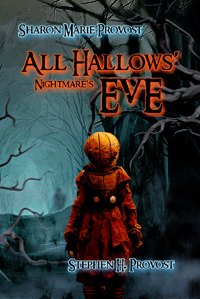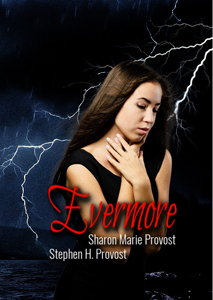Halloween Haunts: Married to Horror: Perspectives of a Collaborating Couple
By Stephen H. Provost
Writers often approach horror from one of two perspectives: Either they’re writers who discover horror, or they’re horror lovers who find an outlet in writing. My wife, Sharon Marie Provost, was a horror fan from childhood. She’s a voracious reader who grew up on Stephen King, and she wrote a vampire-themed short story when she was in grade school. If you ask her whether she’s seen a specific horror film, chances are the answer will be “yes.” I, on the other hand, was a journalist for thirty-two years and had written several other books by the time I tackled horror in 2018. I did it as a challenge to myself. I’d written fantasy and science fiction novels while focusing primarily on historical nonfiction.
Unlike Sharon, I hadn’t grown up reading or watching much horror. I had, however, been a huge fan of science fiction, which often included elements of horror. I still consider the stomach “birthing” scene in Alien the scariest thing I’ve seen on the screen. Jump scares don’t typically work for me, this was a twist I had not been expecting, and it made me all but jump out of my seat.
I’m a sucker for a good twist. Like the jump scare, the audience isn’t expecting it, but it is more than just a momentary shock. It’s something you keep thinking about, wondering how you might have, or whether you should have, seen it coming. The obvious example is the revelation in The Sixth Sense, which people still talk about today.
I am partial to psychological horror, which is a common nexus for horror and science fiction. Novels such as Ray Bradbury’s Fahrenheit 451 and The Martian Chronicles, along with The Twilight Zone and some episodes of Star Trek exemplify this connection, and these are what inspired me. I consciously patterned my first horror collection after The Twilight Zone. Even the title, Nightmare’s Eve, was inspired by the title of Rod Serling’s iconic TV series. That was meant to be a one-off project. It got solid reviews, but once it was done, I went back to writing nonfiction.
Sharon, however, kept suggesting that I write another collection, so I made her a deal: I would write half the stories for a new book if she would write the other half. Until then, she had only written one short story, for an unthemed anthology of tales by Northern Nevada authors, but she took me up on the offer. In December of 2023, we released a Christmas-themed horror collection, the second volume in the now-six-volume Nightmare’s Eve series. Then, three months later, she produced her first solo collection, Shadow’s Gate, which recently won the 2025 Imadjinn Award for Best Short Story Collection.
 Writing horror can be a great way to deal with your own fears, as I did by forcing myself to write a novelette that dealt with claustrophobia. Authors can immerse themselves in worlds that are somehow both more and less terrifying than the one we live in. For Sharon, writing horror has been cathartic, providing an escape and a sense of purpose. After spending twenty years as office manager at a veterinary hospital, she had to stop working an 8-to-5 job nearly three years after being diagnosed with metastatic colon cancer. She is now in her fourth year of chemotherapy, a very real horror in its own right, and writing horror has helped give her the motivation to not just persevere, but thrive.
Writing horror can be a great way to deal with your own fears, as I did by forcing myself to write a novelette that dealt with claustrophobia. Authors can immerse themselves in worlds that are somehow both more and less terrifying than the one we live in. For Sharon, writing horror has been cathartic, providing an escape and a sense of purpose. After spending twenty years as office manager at a veterinary hospital, she had to stop working an 8-to-5 job nearly three years after being diagnosed with metastatic colon cancer. She is now in her fourth year of chemotherapy, a very real horror in its own right, and writing horror has helped give her the motivation to not just persevere, but thrive.
She’s partial to human horror, because it induces the greatest fear in her: It’s something that can actually happen. But we both enjoy working in a variety of subgenres because we like to explore different elements of the genre. We’ve written about ghosts, vampires, serial killers, demons, extraterrestrials, and historical figures placed in terrifying settings.
It’s my firm belief that good writing is good writing, regardless of the genre. Gifted storytellers can write strong science fiction or horror, can produce compelling historical fiction or fantasy. The required skills are the same: an engaging plot, relatable characters, and a command of language. From there, you just add the necessary bells and whistles, based on your research into your chosen genre. I use the word “genre” because I recognize that it helps readers know what they’re getting into when they open a book (or e-file). I’m not fond of it, though, because it can tie a writer’s hands. If you’re worried about conforming to the “rules” of a genre, you’re likely to end up with something that reads like a thousand other stories out there. I value originality, so I tend to wind up with a lot of cross-genre works, and stories that don’t fit neatly into any particular box. I like it that way. Yes, I want to sell books, but not at the price of turning into a color-by-numbers writer working on prepackaged stories.
Where do horror writers get their inspiration? Anywhere and everywhere. Sharon and I have done plenty of road trips researching my historical travelogues of various highways. We’re inspired by what we see along the way, whether it’s an abandoned gas station, the ruins of an old mine, the site of a gruesome killing, or tanks abandoned in a shuttered military facility once used by bombers for target practice. We’re inspired by the books we read and the movies we watch. We’re inspired by our own experiences, whether they involve fighting cancer or being bullied as a child. Almost anything can serve as fodder for a good horror story.
We typically start with a story idea, flesh it out, and then develop the characters. There’s a temptation to make the folks in a story cookie-cutter tropes from horror movies, and we do occasionally do that for comic effect. (Comedy and horror can work very well together.) Most of the time, however, we want to make the people in our stories relatable. It isn’t just a matter of putting two-dimensional characters in a scary situation. It’s about creating empathy by putting complex, very human characters in the reader’s mind and letting them become “friends” going through something horrific.
The best horror, like good science fiction, often provides a commentary on the human condition. It puts us inside the minds of heroes and villains, exposing us to their fears, motivations, and failings. It doesn’t just scare us, it makes us think. And thinking about it allows the horror to linger, like a fine wine… until it turns to the kind of vinegar that gives us nightmares for years to come.
 Stephen H. Provost has written or co-authored more than sixty books, including seven works of horror or thrillers. He is also the editor of twenty books, including Sharon’s award-winning Shadow’s Gate horror collection. The pair recently published the first in a two-volume anthology titled Nevada Nightmares, featuring historic and modern horror and paranormal tales produced by Nevada residents. The second volume is due out in November. Provost is a former reporter and columnist with more than 30 years of experience at daily newspapers. In addition to his works of horror, science fiction, fantasy, and children’s books, he has written extensively in the field of non-fiction, including biographies and historical travelogues. The founder and publisher of Dragon Crown Books, he and Sharon live in Carson City. His books are available on Amazon and at dragoncrownbooks.com.
Stephen H. Provost has written or co-authored more than sixty books, including seven works of horror or thrillers. He is also the editor of twenty books, including Sharon’s award-winning Shadow’s Gate horror collection. The pair recently published the first in a two-volume anthology titled Nevada Nightmares, featuring historic and modern horror and paranormal tales produced by Nevada residents. The second volume is due out in November. Provost is a former reporter and columnist with more than 30 years of experience at daily newspapers. In addition to his works of horror, science fiction, fantasy, and children’s books, he has written extensively in the field of non-fiction, including biographies and historical travelogues. The founder and publisher of Dragon Crown Books, he and Sharon live in Carson City. His books are available on Amazon and at dragoncrownbooks.com.
“The Minister: A Plan is Hatched” – excerpt from Evermore: Dark Soulmates
The graveyard behind our church had been growing quickly of late. Too quickly. A plague of unknown origin had come upon us, sent by Lucifer to test our faith or by God Himself to punish us for some transgression, though I knew not what.
As pastor and leader of our session at Covenant Presbyterian, it was my duty to discover the source of it. I could not simply entrust this duty to another, but had to see to it myself. Therefore, I set up a chair beside the headstone of our most prominent deceased member, deeming it most likely to draw out whatever evil had beset us.
I felt almost as though the spirit of Samuel Smith was looking down at me from heaven’s gates, reproving me for disturbing his slumber. I took small comfort in the knowledge that my own slumber was fitful at best, wrapped in a woolen blanket that barely shielded me from the chill. Sleep was not my objective, in any case. I had charged myself to stay alert for any noise or movement that might signal something was amiss. Every time I fell asleep, my eyes would open with a start at the tiniest hint of some activity in the graveyard.
An owl taking to the wing.
A light breeze brushing my forehead.
A frog croaking out by the pond.
Something unknown skittering through the underbrush.
It was long past midnight when I was awakened by something else: A gaunt, pale man—not more than a boy, really—wearing an old knee-length gown. The moon was in its first quarter, providing enough light to see, but not clearly. The candle I had brought with me had gone out, so I struck flint against silver in my tinderbox, which made a noise that I feared would alert the intruder to my presence.
But he ignored it, and me, as though he were in a trance, walking slowly but deliberately toward one of the smaller gravesites, unmarked except for a small stone carved with the name Teagan. It was, I knew, the resting place of a girl who had been taken less than a fortnight ago by the plague that still beset us.
Fully awake, I watched with keen interest as the stranger walked over to the grave and first sat down, then lay himself prostrate upon it with his arms spread wide to both sides.
I heard his voice, low and still but carried to my ears upon the breeze.
“Teagan, my love. Forgive me. I love thee still. Forgive me.”
He repeated these last two words perhaps a dozen times between sobs before at last falling silent, his body growing still as he fell into either slumber or paralysis or the death-sleep. I knew not which.
I dared not disturb him, fearing that he was possessed by an evil spirit that might spring forth from him and attach itself to me.
The Lord is my shepherd. I shall not want. He maketh me to lie down in green pastures: he leadeth me beside the still waters. He restoreth my soul: he leadeth me in the paths of righteousness for his name’s sake. Yea, though I walk through the valley of the shadow of death, I will fear no evil: for thou art with me…
The twenty-third Psalm had always brought me comfort in the past, but not this time. The words rang hollow inside my head as I stared at the almost ghostly form of the man, lying still as he was atop the grave. It was almost as though he wished to lie with the girl within, in some unholy coupling of the living and the dead.
I could not watch, but neither could I turn away. I sat transfixed, staring at him as he lay there. I thought I could make out his body rising and falling slightly, impelled by the intake and exhalation of air… or perhaps I only imagined it.
The next thing I knew, the rays of the sun were washing warm over my face.
I sat up straight with a start.
The candle had expired, and the young man who had been lying on the grave was gone. I wondered now whether he had ever really been there, or if he might have been a phantom from some fever-dream induced by Satan. I was perspiring heavily, and I felt not the usual hunger to break my fast. I coughed once, then a second time as I rose.
Then a thought occurred to me, of a sudden: Had the young man spread the plague to me?
My hands were shaking as I penned the note alerting the ministers of our sister congregations to what had befallen us. I had met with the elders of the session, and we had determined together that we faced some form of demonic infestation. The situation had grown dire, with more congregants falling ill, both in our own church and nearby. The entire presbytery would be required to deal with the situation.
At our meeting, it was determined that the only course of action must be to exhume the body of the first person to fall ill when the plague was discovered. Doctor Peterman had informed me of Teagan’s illness and its peculiar nature: that the girl had spit up blood, which trickled from her lips, and that her body had repelled the leeches he had brought to give her succor.
“The nature of her illness is clear to me now,” he said as he stood before the assembly. “This is, I fear, a case of vampirism. The blood on the girl’s lips was not her own, but belonged to others on whom she was feeding.”
“Did anyone who fell ill visit her in her failed convalescence?” The voice was that of Cyrus Hoagland, one of the senior deacons in our own congregation.
“I was only there for an hour or so,” the doctor demurred. “But they must have. There is no other explanation.”
Harlan Blackmore, one of the elders, spoke up: “Remember, her father was found dead only one day after she was lain in the ground, gutted by a pitchfork in his own home. She must have risen from the grave in the dead of night, returned to the home, and killed him to partake of his blood.”
“This is absurd,” Michael Alden said. He was one of the youngest members of the council and one of the least apt to follow the others’ opinions. Those others, it was not surprising, did not welcome his presence among them. “A dead woman rising from the grave? Have you taken leave of your senses?”
“Hardly,” Elder Blackmore sniffed, looking down his long patrician nose at the young deacon. “Or have you forgotten the scripture? It states plainly that, when our Lord breathed his last, the graves were opened, and many bodies of the saints which slept arose.”
“Saints and vampires are quite different things,” Deacon Alden retorted.
“Nevertheless, the dead may be truly animated by the will of God, or may be brought back in a facsimile of their former selves by the prince of darkness, who will send many in the Lord’s name declaring ‘I am Christ.’ Perhaps this is owing to the fact that they, like Christ, have been raised from the dead—yet unnaturally, by the devil.”
“What does it profit us to bicker so?” Deacon Hoagland said. “If she is not a vampire, no harm will have been done. Minister Fillmore can consecrate the ground anew, and she can be left in peace.
“But if she is a vampire, we can put an end to the scourge she spread by exhuming her remains. This practice, gentlemen, is well-established. If the corpse is in a lifelike state and blood is found within her, we will know she has been turned. Then we can move forward with the procedure of beheading her, pulling the heart from her chest, and burning her body. The heart we can reduce to a tonic that all the townsfolk may receive to inoculate them against this evil.”
A murmur of approval arose around the table.
“And what of the young man Minister Fillmore saw visiting her in the graveyard?”
“We can only hope that destroying her corpse will release him from her thrall, and that the tonic will cure him if he is infected,” Deacon Hoagland said.
“And if it does not?”
“Then,” Elder Blackmore announced, “we will have to kill him.”

For an opportunity to win a copy of All Hallows’ Nightmare’s Eve, please comment below. One lucky commenter will be drawn at random and receive the book!

